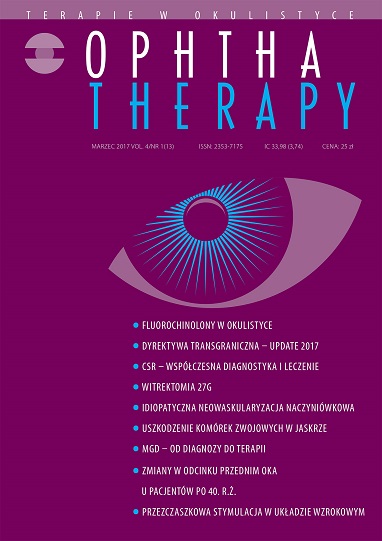Dysfunkcja gruczołów Meiboma – wyzwania diagnostyczne i terapeutyczne
##plugins.themes.bootstrap3.article.main##
Abstrakt
Dysfunkcja gruczołów Meiboma (MGD, Meibomian gland dysfunction) jest jednym z najczęściej stwierdzanych schorzeń okulistycznych. Do jej objawów należą: zapalenie, nadmierne wydzielanie i nieprawidłowy skład wydzieliny gruczołów Meiboma. Rosnąca świadomość znaczenia MGD wymusza poszukiwanie skuteczniejszych metod terapii. Pomimo wielu tradycyjnych sposobów leczenia, takich jak ciepłe kompresy i higiena powiek zmniejszająca ilość zalegającej wydzieliny łojowej oraz podawanie antybiotyków i leków przeciwzapalnych wpływających na jakość wydzieliny gruczołowej, terapia MGD pozostaje wyzwaniem. Nowe metody leczenia MGD mogą odegrać istotną rolę w ograniczaniu oznak i objawów klinicznych choroby.
Pobrania
##plugins.themes.bootstrap3.article.details##

Utwór dostępny jest na licencji Creative Commons Uznanie autorstwa – Użycie niekomercyjne – Bez utworów zależnych 4.0 Międzynarodowe.
Copyright: © Medical Education sp. z o.o. License allowing third parties to copy and redistribute the material in any medium or format and to remix, transform, and build upon the material, provided the original work is properly cited and states its license.
Address reprint requests to: Medical Education, Marcin Kuźma (marcin.kuzma@mededu.pl)
Bibliografia
2. Bron AJ. The Doyne lecture: reflections on the tears. Eye (Lond). 1997; 11(Pt 5): 583-602.
3. Stern ME, Gao J, Siemasko KF et al. The role of the lacrimal functional unit in the pathophysiology of dry eye. Exp Eye Res. 2004; 78: 409-16.
4. Bron AJ, Tiffany JM, Gouveia SM et al. Functional aspects of the tear film lipid layer. Exp Eye Res. 2004; 78(3): 347-60.
5. Butovich IA, Millar TJ, Ham BM. Understanding and analyzing Meibomian lipids. A review. Curr Eye Res. 2008; 33(5): 405-20.
6. King-Smith PE, Fink BA, Hill RM et al. The thickness of the tear film. Curr Eye Res. 2004; 29(4-5): 357-68.
7. Den S, Shimizu K, Ikeda T et al. Association between meibomian gland changes and aging, sex, or tear function. Cornea. 2006; 25(6): 651-5.
8 Matsumoto Y, Dogru M, Goto E et al. Alterations of the tear film and ocular surface health in chronic smokers. Eye. 2008; 22(7): 961-8. https://doi.org/10.1038/eye.2008.78.
9. Schaumberg DA, Buring JE, Sullivan DA et al. Hormone replacement therapy and dry eye syndrome. JAMA. 2001; 286(17): 2114-9.
10. Suzuki T, Schirra F, Richards SM et al. Estrogen and progesterone control of gene expression in the mouse meibomian gland. Invest Ophthalmol Vis Sci. 2008; 49(5): 1797-808. https://doi.org/10.1167/iovs.07-1458.
11. Madden LC, Tomlinson A, Simmons PA. Effect of humidity variations in a controlled environment chamber on tear evaporation after dry eye therapy. Eye Contact Lens. 2013; 39(2): 169-74.
12. Lee S, Lam S, Luk F. Investigation of cabin air quality in commercial aircrafts. Proc Healthy Build. 2000; 1: 471-6.
13. Mathers WD, Choi D. Cluster analysis of patients with ocular surface disease, blepharitis, and dry eye. Arch Ophthalmol. 2004; 122(11): 1700-4.
14. Arita R, Itoh K, Maeda S et al. Efficacy of diagnostic criteria for the differential diagnosis between obstructive meibomian gland dysfunction and aqueous deficiency dry eye. Jpn J Ophthalmol. 2010; 54(5): 387-91.
15. Pult H, Nichols JJ. A review of meibography. Optom Vis Sci. 2012; 89(5): E760-9.
16. Yamaguchi M, Kutsuna M, Uno T et al. Marx Line: Fluorescein Staining Line on the Inner Lid as Indicator of Meibomian Gland Function. Am J Ophthalmol. 2006; 141(4): 669-675. https://doi.org/10.1016/j.ajo.2005.11.004.
17. Olson MC, Korb DR, Greiner JV. Increase in tear film lipid layer thickness following treatment with warm compresses in patients with meibomian gland dysfunction. Eye Contact Lens. 2003; 29(2): 96-9.
18. Lallemand F, Daull P, Benita S et al. Successfully improving ocular drug delivery using the cationic nanoemulsion, novasorb. J Drug Deliv. 2012; 2012: 604204.
19. Akyol-Salman I, Azizi S, Mumcu UY et al. Comparison of the efficacy of topical N-acetyl-cysteine and a topical steroid-antibiotic combination therapy in the treatment of meibomian gland dysfunction. J Ocul Pharmacol Ther. 2012; 28(1): 49-52.
20. Macsai MS. The role of omega-3 dietary supplementation in blepharitis and meibomian gland dysfunction (an AOS thesis). Trans Am Ophthalmol Soc. 2008; 106: 336-56.
21. Pflugfelder SC, Solomon A, Stern ME. The diagnosis and management of dry eye: a twenty-five-year review. Cornea. 2000; 19: 644-9.
22. Perry HD, Doshi-Carnevale S, Donnenfeld ED et al. Efficacy of commercially available topical cyclosporine A 0.05% in the treatment of meibomian gland dysfunction. Cornea. 2006; 25(2): 171-5.
23. Foulks GN, Borchman D, Yappert M et al. Topical azithromycin therapy for meibomian gland dysfunction: clinical response and lipid alterations. Cornea. 2010; 29(7): 781-788. https://doi.org/10.1097/ICO.0b013e3181cda38f.
24. Geerling G, Tauber J, Baudouin C et al. The international workshop on meibomian gland dysfunction: report of the subcommittee on management and treatment of meibomian gland dysfunction. Invest Ophth Vis Sci. 2011; 52(4): 2050-64.
25. Craig JP, Chen YH, Turnbull PR. Prospective trial of intense pulsed light for the treatment of meibomian gland dysfunction. Invest Ophthalmol Vis Sci. 2015; 56(3): 1965-70.

